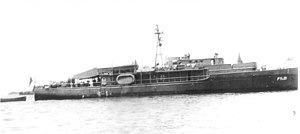USS Alabaster (PYc-21)

USS Alabaster (PYc-21) at anchor in San Pedro Bay, Philippine Islands while at Navy Yard for modification. c. July 1945
|
|
| History | |
|---|---|
| Name: | Ronaele |
| Owner: | William F. Ladd |
| Builder: | Mathis Yacht Building Company, Camden, New Jersey |
| Launched: | 1932 |
| Name: | Ronaele |
| Owner: | Lucius B. Manning |
| Acquired: | 1934 |
| Fate: | Sold back to William F. Ladd in 1936 |
| Name: | Rellimpa, Ranley and Ronaele |
| Owner: | William F. Ladd |
| Acquired: | 1936 |
| Fate: | Sold to the Navy 3 January 1942 |
| Name: | USS Alabaster (PYc-21) |
| Namesake: | Alamo |
| Builder: | Philadelphia Navy Yard |
| Acquired: | 3 January 1942 |
| Commissioned: | 31 January 1942 |
| Decommissioned: | 17 December 1945 |
| Struck: | 21 January 1946 |
| Fate: |
|
| General characteristics | |
| Type: | Patrol boat |
| Displacement: | 230 long tons (234 t) |
| Length: | 143 ft (44 m) |
| Beam: | 23 ft 5 in (7.14 m) |
| Draft: | 12 ft 5 in (3.78 m) |
| Speed: | 14.5 knots (26.9 km/h; 16.7 mph) |
| Complement: | 48 |
| Armament: |
|
USS Alabaster (PYc-21) was a coastal patrol yacht of the United States Navy during World War II.
The ship was built in 1932 by the Mathis Yacht Building Co. of Camden, New Jersey, as the yacht Alamo as confirmed by the oval shipbuilder's plate affixed in the upper access portion of its engine room. It was acquired by the U.S. Navy on 3 January 1942, renamed Alabaster on 13 January 1942 and simultaneously classified a coastal patrol yacht and designated PYc-21. Converted by the Philadelphia Navy Yard for naval service, it was commissioned on 31 January 1942, with Lt.Cmdr. A. F. Edel, USNR, in command.
Assigned to the Inshore Patrol and based at the section base at Cape May, New Jersey, Alabaster began patrolling the coast of the United States from Delaware Bay to Chesapeake Bay early in February and continued that assignment through the remainder of 1942 and most of 1943. In September 1943, the Navy decided to convert the vessel to an anti-submarine warfare (ASW) training platform. She spent the next two months in the Philadelphia Navy Yard receiving the modifications needed to prepare her to carry out her new mission, On 30 November, she stood out of Philadelphia, bound for the Naval Air Station Quonset Point, Rhode Island. The following day, the patrol yacht reported for duty with the Commander, Anti-submarine Development, Atlantic Fleet, at Quonset Point and began a month of training to ready her crew for the new assignment.
On 5 January 1944, she completed her training and received orders to report to the Commander, Eastern Sea Frontier for routing to the Canal Zone. Alabaster departed Cape May on 10 January and steamed — via Charleston, Miami, and Guantanamo Bay — to Balboa, Canal Zone, where she arrived on the 25th. The ship reported for duty with the 7th Fleet and got underway on 1 February with an oil tanker bound for Australia. The patrol yacht entered port at Cairns, Australia, on St. Patrick's Day, but put to sea again on 25 March. The little warship arrived in Milne Bay, New Guinea, where she remained for about three months instructing Navy men in the use of various ASW devices. In mid-June, she moved to Seeadler Harbor at Manus in the Admiralty Islands where she resumed ASW training duties. On 19 October, she departed Manus to return to New Guinea and dropped anchor at Hollandia on the 21st. She remained at that base until the end of January 1945, providing ASW training services and making emergency repairs to radar and sonar equipment, On 31 January 1945, she weighed anchor and shaped a course for the Philippines. Alabaster arrived in San Pedro Bay, Leyte, on 6 February and resumed her previous training and repair missions.
...
Wikipedia
